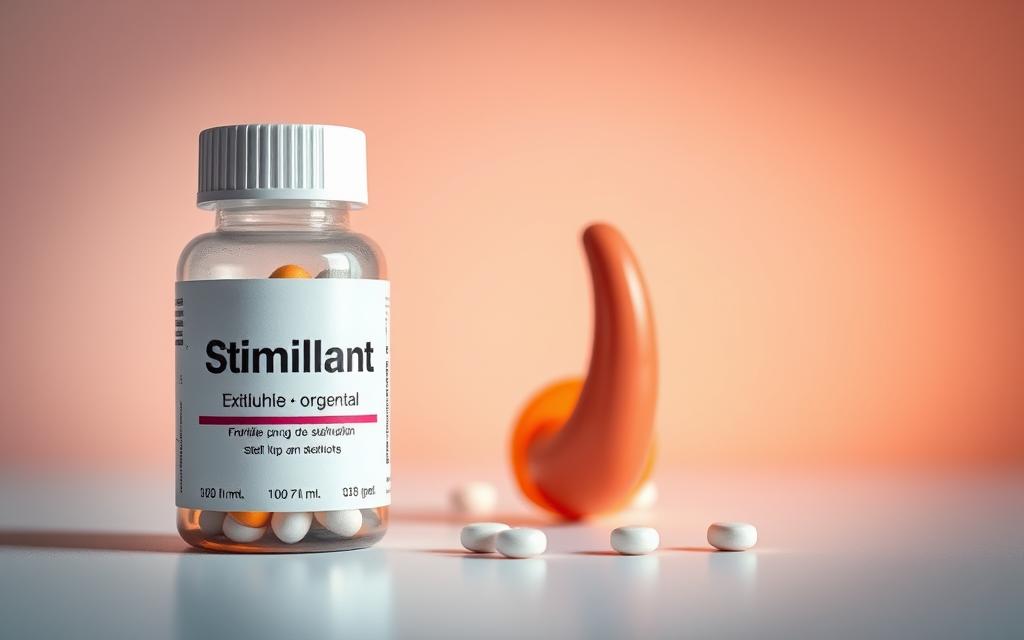How Stimulants Help with Erectile Dysfunction: Benefits & Effects Explained
Understanding the complex relationship between stimulants and sexual health is crucial, especially when it comes to addressing erectile dysfunction (ED). Recent discussions have centered around the impact of cannabis on ED, sparking interest in its potential benefits and drawbacks.
Stimulants, including cannabis, have been explored for their effects on sexual function. While some studies suggest that certain stimulants may enhance sexual experience, others raise concerns about their potential to exacerbate ED. This section will provide an overview of the current understanding of how stimulants affect ED.
By examining the available research, we aim to shed light on the benefits and potential risks associated with using stimulants to address ED, setting the stage for a more in-depth exploration in subsequent sections.
Understanding Erectile Dysfunction: Causes and Prevalence
Erectile dysfunction (ED) is a condition that affects millions of men worldwide, causing significant distress and impacting quality of life. To address ED effectively, it’s essential to understand its underlying causes and how prevalent it is among different populations.
Common Causes of ED
Erectile dysfunction can result from a variety of factors, including underlying health conditions such as diabetes, heart disease, and obesity. Lifestyle choices, such as smoking and excessive alcohol consumption, can also contribute to ED.
- Diabetes
- Heart disease
- Obesity
- Smoking
- Excessive alcohol consumption
Psychological vs. Physical Factors
ED can be attributed to both psychological and physical factors. Psychological factors include stress, anxiety, and depression, while physical factors encompass conditions like hypertension, neurological disorders, and hormonal imbalances. Understanding whether ED is primarily psychological or physical in nature is crucial for determining the most appropriate treatment approach.
Traditional Treatments for Erectile Dysfunction
Managing erectile dysfunction effectively often involves exploring established treatment pathways. Traditional treatments have been developed to address the various underlying causes of ED, offering a range of options for individuals.
Prescription Medications
One of the most common approaches to treating ED involves prescription medications, particularly PDE5 inhibitors such as sildenafil. These medications work by enhancing blood flow to the penis, facilitating erections. For more information on other treatment options, including testosterone boosters, visit Colorado Urologists.
Non-Pharmaceutical Approaches
In addition to prescription medications, non-pharmaceutical approaches can be effective. These include lifestyle changes, counseling, and the use of vacuum erection devices. The following table summarizes some common non-pharmaceutical treatments:
| Treatment | Description | Benefits |
|---|---|---|
| Lifestyle Changes | Diet, exercise, and quitting smoking | Improves overall health and ED symptoms |
| Counseling | Psychological therapy | Addresses underlying psychological causes |
| Vacuum Erection Devices | Mechanical devices to aid erection | Non-invasive, effective for some men |
By understanding these traditional treatment options, individuals can make informed decisions about their care, potentially incorporating stimulants or other complementary approaches under medical guidance.
The Relationship Between Erectile Dysfunction and Weed
Erectile dysfunction and cannabis use have a complex relationship that is influenced by various factors, including historical use, current research, and personal experiences. Understanding this relationship requires a multifaceted approach.
Historical Use of Cannabis for Sexual Health
Cannabis has been used for centuries to address various health concerns, including sexual health issues. Historically, it was believed to enhance sexual pleasure and performance. Ancient cultures used cannabis in rituals and as an aphrodisiac, suggesting its potential benefits for sexual health.
Current Research Findings
Recent studies have investigated the impact of cannabis on erectile dysfunction, yielding mixed results. Some research suggests that cannabis may improve sexual function by reducing anxiety and enhancing pleasure, while other studies indicate potential negative effects on erectile function due to its impact on cardiovascular health and hormone regulation.
Anecdotal Evidence and Case Studies
Anecdotal evidence and case studies provide valuable insights into the real-world effects of cannabis on erectile dysfunction. Some individuals report improved sexual function, while others experience worsening symptoms. A comprehensive review of these accounts can help identify patterns and potential factors influencing the relationship between cannabis use and ED.
- Cannabis may have both positive and negative effects on erectile dysfunction.
- Historical use suggests cannabis was once considered beneficial for sexual health.
- Current research is ongoing, with mixed findings regarding cannabis’s impact on ED.
How Cannabis Affects Sexual Function
Understanding how cannabis influences sexual function requires a deep dive into its interaction with the human body’s endocannabinoid system. The endocannabinoid system plays a crucial role in regulating various physiological processes, including those related to sexual health.
Endocannabinoid System and Sexual Response
The endocannabinoid system is involved in modulating sexual response, including arousal and erectile function. Cannabinoids interact with cannabinoid receptors in the body, which can influence the release of neurotransmitters and hormones essential for sexual function.

THC vs. CBD Effects on Erectile Function
THC (tetrahydrocannabinol) and CBD (cannabidiol) are two major cannabinoids found in cannabis, each having different effects on erectile function. THC can potentially cause vasodilation, which might improve erectile function in some individuals. However, high doses of THC can also have negative effects, such as reducing libido. On the other hand, CBD may help reduce anxiety and stress, potentially improving sexual function indirectly.
| Cannabinoid | Effects on Erectile Function | Potential Benefits |
|---|---|---|
| THC | Can cause vasodilation, potentially improving erectile function | May enhance sexual experience at low doses |
| CBD | May reduce anxiety and stress, indirectly improving sexual function | Can help with pain management, potentially improving sexual comfort |
Dosage Considerations and Consumption Methods
The effect of cannabis on sexual function can significantly vary based on the dosage and method of consumption. Smoking or vaping cannabis can lead to quicker onset of effects compared to edibles. However, the duration and intensity of the effects can differ based on the individual and the specific product used.
In conclusion, cannabis affects sexual function in complex ways, influenced by factors such as the type of cannabinoid, dosage, and method of consumption. Understanding these factors can help individuals make informed decisions about using cannabis for sexual health.
Other Stimulants and Their Impact on ED
Several stimulants, including those beyond cannabis, have shown potential in alleviating ED symptoms. While cannabis has been a topic of discussion regarding erectile dysfunction, other substances like caffeine and nicotine also play significant roles in sexual health.
Caffeine and Erectile Function
Caffeine, a widely consumed stimulant, has been observed to have both positive and negative effects on erectile function. Moderate caffeine consumption may enhance erectile function by improving blood flow and boosting energy levels. However, excessive intake can lead to negative effects such as anxiety and jitteriness, potentially worsening ED symptoms.
Nicotine and Other Common Stimulants
Nicotine, found in tobacco products, is another stimulant that affects erectile function. Research indicates that nicotine can initially stimulate sexual arousal but may ultimately worsen ED due to its negative impact on vascular health. Other stimulants, such as certain medications and recreational drugs, can have varied effects on ED, depending on their mechanism of action and individual response.
Comparing Different Stimulants’ Effectiveness
When comparing the effectiveness of different stimulants for ED, it’s crucial to consider both their potential benefits and risks. While some stimulants may offer temporary relief or improvement in erectile function, others may have adverse effects or interact negatively with other health conditions or medications.
Potential Benefits and Risks of Using Stimulants for ED
The use of stimulants in treating erectile dysfunction presents both opportunities and challenges. As we explore the potential benefits and risks, it’s essential to consider how these substances affect sexual performance and overall health.
Positive Effects on Sexual Performance
Stimulants can enhance sexual performance by increasing arousal and improving erectile function. Some key benefits include:
- Increased libido
- Improved erectile rigidity
- Enhanced sexual satisfaction
Key stimulants like caffeine and certain medications can have these positive effects. However, individual results can vary widely.
Possible Side Effects and Concerns
While stimulants can offer benefits, they also come with potential risks. It’s crucial to understand both the short-term and long-term implications.
Short-term Risks
Short-term risks associated with stimulant use for ED include:
- Increased heart rate and blood pressure
- Anxiety and jitteriness
- Sleep disturbances
Long-term Considerations
Long-term use of stimulants can lead to:
- Dependence and addiction
- Cardiovascular complications
- Potential for increased tolerance, reducing effectiveness over time
It’s vital to consult with a healthcare professional before using stimulants for ED to discuss potential benefits and risks and determine the best course of treatment.

Combining Stimulants with Traditional ED Treatments
For men dealing with erectile dysfunction, the idea of combining stimulants with established treatments can be both intriguing and complex. This approach may offer enhanced benefits, but it also requires careful consideration of potential interactions and safety concerns.
Potential Interactions with ED Medications
When combining stimulants with traditional ED treatments, it’s crucial to understand how these substances interact. Certain stimulants can enhance the effects of ED medications, while others may increase the risk of side effects. For instance, combining stimulants like caffeine or certain prescription medications with ED treatments can lead to increased heart rate or blood pressure.
Safety Considerations
Safety is a paramount concern when combining stimulants with ED treatments. Key safety considerations include:
- Monitoring blood pressure and heart rate
- Avoiding excessive doses of stimulants
- Being aware of potential side effects, such as anxiety or insomnia
Talking to Your Doctor About Combined Approaches
Before adopting a combined approach, it’s essential to consult with a healthcare provider. They can help determine the safest and most effective treatment plan tailored to individual needs. Discussing medical history, current medications, and any concerns about combining stimulants with ED treatments is vital.
Conclusion: Making Informed Decisions About Stimulants and ED
Understanding the complex relationship between stimulants and erectile dysfunction is crucial for making informed decisions about treatment options. The discussion around erectile dysfunction and weed, as well as other stimulants for ED, highlights the need for a comprehensive approach to addressing this condition.
While stimulants may offer potential benefits, it’s essential to consult with healthcare professionals before making any changes to your treatment regimen. They can help you weigh the pros and cons of using stimulants for ED and ensure safe interactions with other medications.
By staying informed and working closely with your healthcare provider, you can develop a personalized treatment plan that addresses your unique needs and promotes overall well-being.
